Analyzing Anxiety: A University Mental Health Case Study
VerifiedAdded on 2023/06/16
|11
|3253
|454
Case Study
AI Summary
This case study delves into anxiety as a significant mental health disorder, focusing on a 22-year-old university student named Georgia who struggles with overwhelming stress, concentration difficulties, and panic attacks related to academic assessments. The essay explores the intricate relationship between mental and physical health, emphasizing how anxiety can lead to insomnia, breathing problems, and heart palpitations. It discusses the concept of personal recovery, outlining the stages involved in improving mental health and well-being, such as understanding the problem, challenging negative thoughts, and embracing self-acceptance. Various treatment options are considered, including cognitive behavioral therapy (CBT), exposure therapy, and pharmacological interventions like Benzodiazepines and SSRIs. The study underscores the importance of empathy and a humanitarian approach from healthcare professionals in treating mental illnesses, advocating for a cognitive and philosophical understanding of the patient's condition beyond mere medical interventions. The aim is to improve the psychological well-being of individuals and society, breaking down taboos associated with mental health treatment.
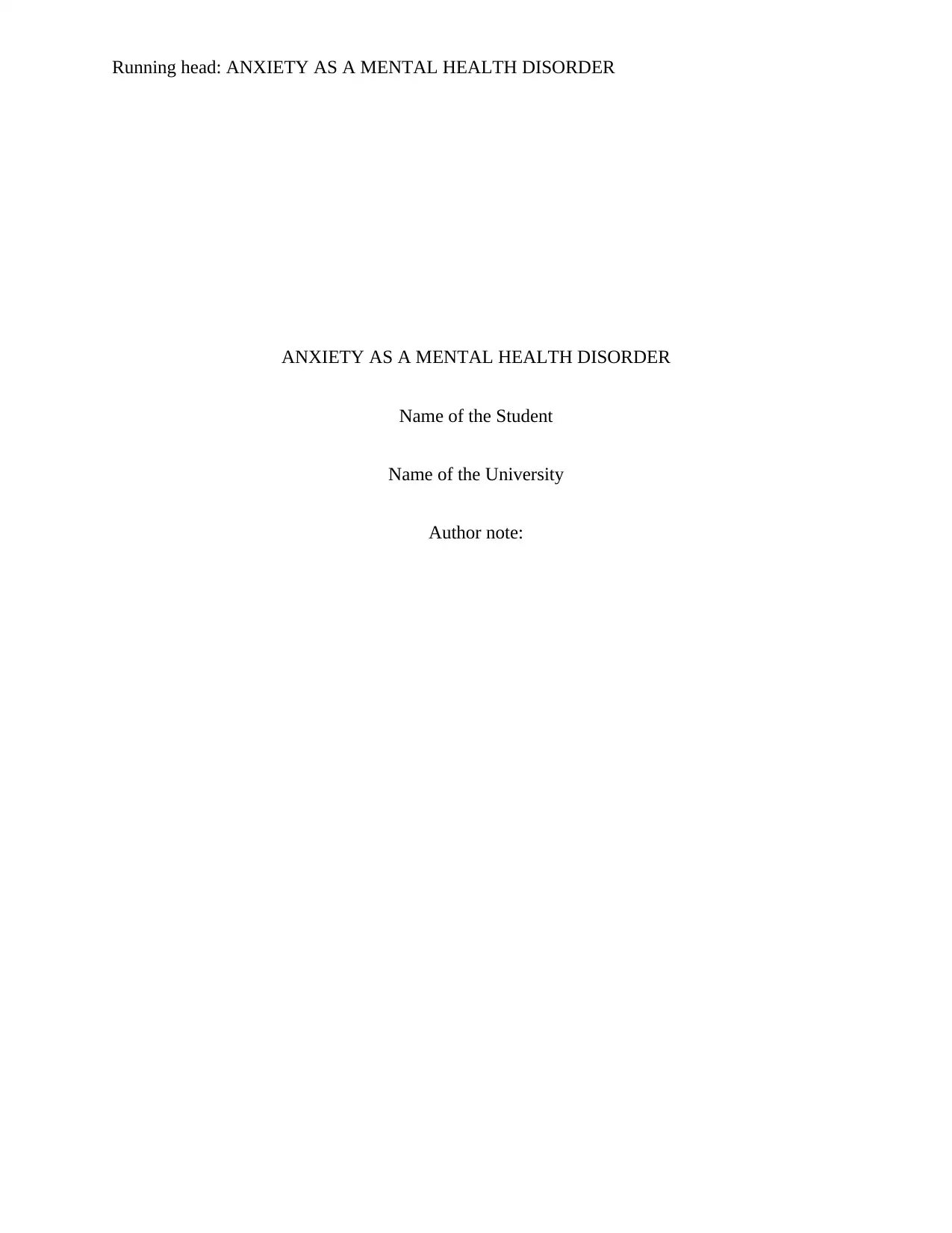
Running head: ANXIETY AS A MENTAL HEALTH DISORDER
ANXIETY AS A MENTAL HEALTH DISORDER
Name of the Student
Name of the University
Author note:
ANXIETY AS A MENTAL HEALTH DISORDER
Name of the Student
Name of the University
Author note:
Paraphrase This Document
Need a fresh take? Get an instant paraphrase of this document with our AI Paraphraser
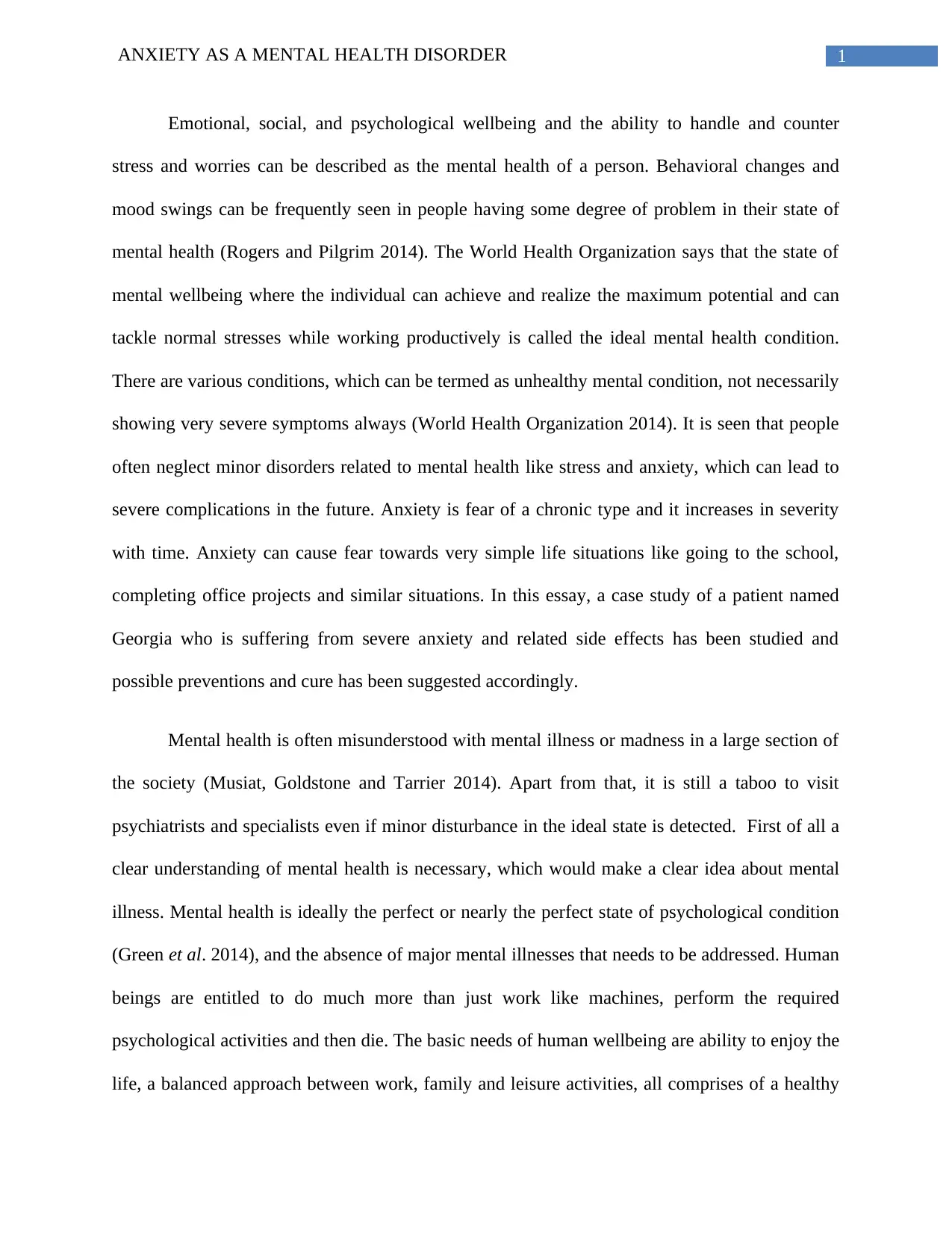
1ANXIETY AS A MENTAL HEALTH DISORDER
Emotional, social, and psychological wellbeing and the ability to handle and counter
stress and worries can be described as the mental health of a person. Behavioral changes and
mood swings can be frequently seen in people having some degree of problem in their state of
mental health (Rogers and Pilgrim 2014). The World Health Organization says that the state of
mental wellbeing where the individual can achieve and realize the maximum potential and can
tackle normal stresses while working productively is called the ideal mental health condition.
There are various conditions, which can be termed as unhealthy mental condition, not necessarily
showing very severe symptoms always (World Health Organization 2014). It is seen that people
often neglect minor disorders related to mental health like stress and anxiety, which can lead to
severe complications in the future. Anxiety is fear of a chronic type and it increases in severity
with time. Anxiety can cause fear towards very simple life situations like going to the school,
completing office projects and similar situations. In this essay, a case study of a patient named
Georgia who is suffering from severe anxiety and related side effects has been studied and
possible preventions and cure has been suggested accordingly.
Mental health is often misunderstood with mental illness or madness in a large section of
the society (Musiat, Goldstone and Tarrier 2014). Apart from that, it is still a taboo to visit
psychiatrists and specialists even if minor disturbance in the ideal state is detected. First of all a
clear understanding of mental health is necessary, which would make a clear idea about mental
illness. Mental health is ideally the perfect or nearly the perfect state of psychological condition
(Green et al. 2014), and the absence of major mental illnesses that needs to be addressed. Human
beings are entitled to do much more than just work like machines, perform the required
psychological activities and then die. The basic needs of human wellbeing are ability to enjoy the
life, a balanced approach between work, family and leisure activities, all comprises of a healthy
Emotional, social, and psychological wellbeing and the ability to handle and counter
stress and worries can be described as the mental health of a person. Behavioral changes and
mood swings can be frequently seen in people having some degree of problem in their state of
mental health (Rogers and Pilgrim 2014). The World Health Organization says that the state of
mental wellbeing where the individual can achieve and realize the maximum potential and can
tackle normal stresses while working productively is called the ideal mental health condition.
There are various conditions, which can be termed as unhealthy mental condition, not necessarily
showing very severe symptoms always (World Health Organization 2014). It is seen that people
often neglect minor disorders related to mental health like stress and anxiety, which can lead to
severe complications in the future. Anxiety is fear of a chronic type and it increases in severity
with time. Anxiety can cause fear towards very simple life situations like going to the school,
completing office projects and similar situations. In this essay, a case study of a patient named
Georgia who is suffering from severe anxiety and related side effects has been studied and
possible preventions and cure has been suggested accordingly.
Mental health is often misunderstood with mental illness or madness in a large section of
the society (Musiat, Goldstone and Tarrier 2014). Apart from that, it is still a taboo to visit
psychiatrists and specialists even if minor disturbance in the ideal state is detected. First of all a
clear understanding of mental health is necessary, which would make a clear idea about mental
illness. Mental health is ideally the perfect or nearly the perfect state of psychological condition
(Green et al. 2014), and the absence of major mental illnesses that needs to be addressed. Human
beings are entitled to do much more than just work like machines, perform the required
psychological activities and then die. The basic needs of human wellbeing are ability to enjoy the
life, a balanced approach between work, family and leisure activities, all comprises of a healthy
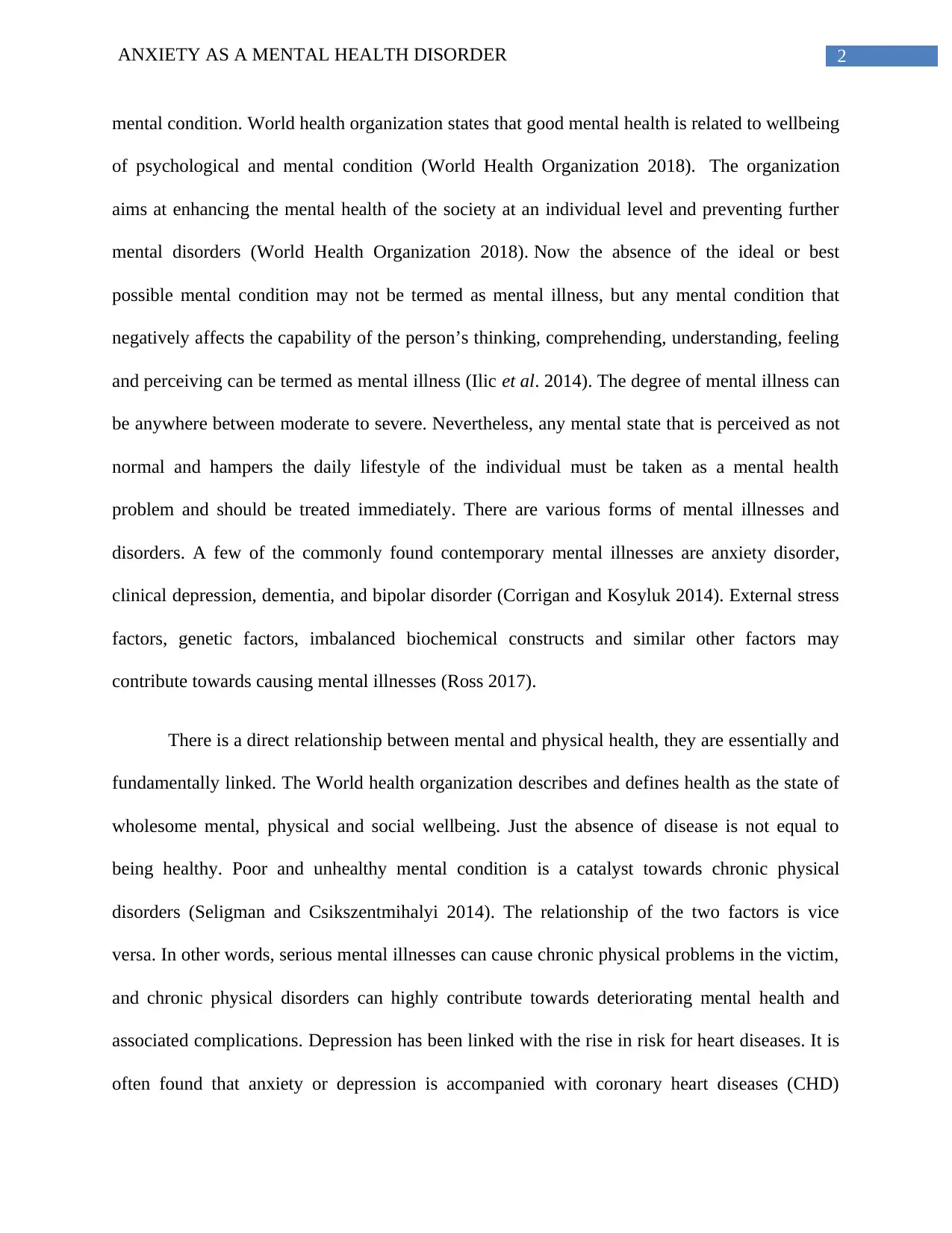
2ANXIETY AS A MENTAL HEALTH DISORDER
mental condition. World health organization states that good mental health is related to wellbeing
of psychological and mental condition (World Health Organization 2018). The organization
aims at enhancing the mental health of the society at an individual level and preventing further
mental disorders (World Health Organization 2018). Now the absence of the ideal or best
possible mental condition may not be termed as mental illness, but any mental condition that
negatively affects the capability of the person’s thinking, comprehending, understanding, feeling
and perceiving can be termed as mental illness (Ilic et al. 2014). The degree of mental illness can
be anywhere between moderate to severe. Nevertheless, any mental state that is perceived as not
normal and hampers the daily lifestyle of the individual must be taken as a mental health
problem and should be treated immediately. There are various forms of mental illnesses and
disorders. A few of the commonly found contemporary mental illnesses are anxiety disorder,
clinical depression, dementia, and bipolar disorder (Corrigan and Kosyluk 2014). External stress
factors, genetic factors, imbalanced biochemical constructs and similar other factors may
contribute towards causing mental illnesses (Ross 2017).
There is a direct relationship between mental and physical health, they are essentially and
fundamentally linked. The World health organization describes and defines health as the state of
wholesome mental, physical and social wellbeing. Just the absence of disease is not equal to
being healthy. Poor and unhealthy mental condition is a catalyst towards chronic physical
disorders (Seligman and Csikszentmihalyi 2014). The relationship of the two factors is vice
versa. In other words, serious mental illnesses can cause chronic physical problems in the victim,
and chronic physical disorders can highly contribute towards deteriorating mental health and
associated complications. Depression has been linked with the rise in risk for heart diseases. It is
often found that anxiety or depression is accompanied with coronary heart diseases (CHD)
mental condition. World health organization states that good mental health is related to wellbeing
of psychological and mental condition (World Health Organization 2018). The organization
aims at enhancing the mental health of the society at an individual level and preventing further
mental disorders (World Health Organization 2018). Now the absence of the ideal or best
possible mental condition may not be termed as mental illness, but any mental condition that
negatively affects the capability of the person’s thinking, comprehending, understanding, feeling
and perceiving can be termed as mental illness (Ilic et al. 2014). The degree of mental illness can
be anywhere between moderate to severe. Nevertheless, any mental state that is perceived as not
normal and hampers the daily lifestyle of the individual must be taken as a mental health
problem and should be treated immediately. There are various forms of mental illnesses and
disorders. A few of the commonly found contemporary mental illnesses are anxiety disorder,
clinical depression, dementia, and bipolar disorder (Corrigan and Kosyluk 2014). External stress
factors, genetic factors, imbalanced biochemical constructs and similar other factors may
contribute towards causing mental illnesses (Ross 2017).
There is a direct relationship between mental and physical health, they are essentially and
fundamentally linked. The World health organization describes and defines health as the state of
wholesome mental, physical and social wellbeing. Just the absence of disease is not equal to
being healthy. Poor and unhealthy mental condition is a catalyst towards chronic physical
disorders (Seligman and Csikszentmihalyi 2014). The relationship of the two factors is vice
versa. In other words, serious mental illnesses can cause chronic physical problems in the victim,
and chronic physical disorders can highly contribute towards deteriorating mental health and
associated complications. Depression has been linked with the rise in risk for heart diseases. It is
often found that anxiety or depression is accompanied with coronary heart diseases (CHD)
⊘ This is a preview!⊘
Do you want full access?
Subscribe today to unlock all pages.

Trusted by 1+ million students worldwide
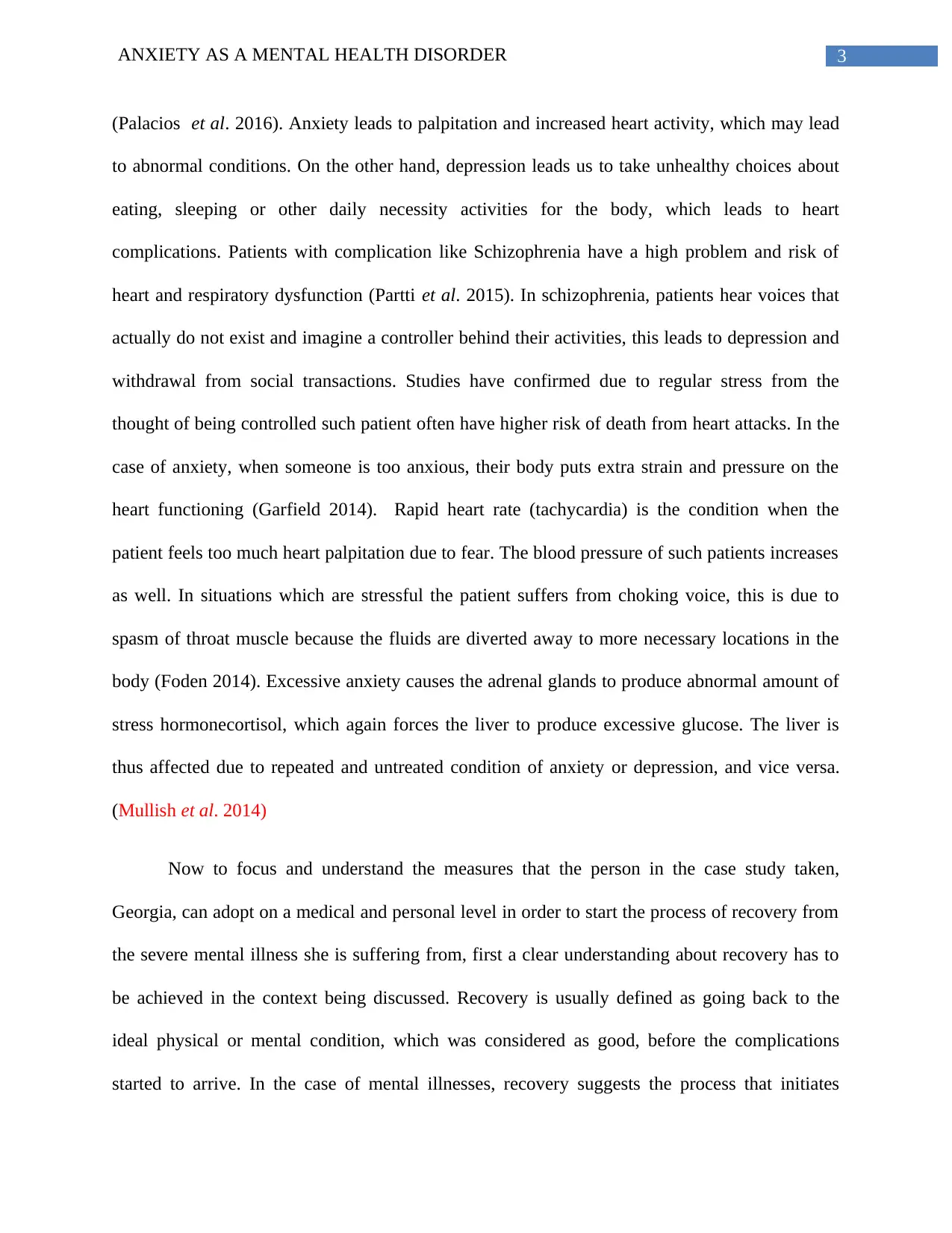
3ANXIETY AS A MENTAL HEALTH DISORDER
(Palacios et al. 2016). Anxiety leads to palpitation and increased heart activity, which may lead
to abnormal conditions. On the other hand, depression leads us to take unhealthy choices about
eating, sleeping or other daily necessity activities for the body, which leads to heart
complications. Patients with complication like Schizophrenia have a high problem and risk of
heart and respiratory dysfunction (Partti et al. 2015). In schizophrenia, patients hear voices that
actually do not exist and imagine a controller behind their activities, this leads to depression and
withdrawal from social transactions. Studies have confirmed due to regular stress from the
thought of being controlled such patient often have higher risk of death from heart attacks. In the
case of anxiety, when someone is too anxious, their body puts extra strain and pressure on the
heart functioning (Garfield 2014). Rapid heart rate (tachycardia) is the condition when the
patient feels too much heart palpitation due to fear. The blood pressure of such patients increases
as well. In situations which are stressful the patient suffers from choking voice, this is due to
spasm of throat muscle because the fluids are diverted away to more necessary locations in the
body (Foden 2014). Excessive anxiety causes the adrenal glands to produce abnormal amount of
stress hormonecortisol, which again forces the liver to produce excessive glucose. The liver is
thus affected due to repeated and untreated condition of anxiety or depression, and vice versa.
(Mullish et al. 2014)
Now to focus and understand the measures that the person in the case study taken,
Georgia, can adopt on a medical and personal level in order to start the process of recovery from
the severe mental illness she is suffering from, first a clear understanding about recovery has to
be achieved in the context being discussed. Recovery is usually defined as going back to the
ideal physical or mental condition, which was considered as good, before the complications
started to arrive. In the case of mental illnesses, recovery suggests the process that initiates
(Palacios et al. 2016). Anxiety leads to palpitation and increased heart activity, which may lead
to abnormal conditions. On the other hand, depression leads us to take unhealthy choices about
eating, sleeping or other daily necessity activities for the body, which leads to heart
complications. Patients with complication like Schizophrenia have a high problem and risk of
heart and respiratory dysfunction (Partti et al. 2015). In schizophrenia, patients hear voices that
actually do not exist and imagine a controller behind their activities, this leads to depression and
withdrawal from social transactions. Studies have confirmed due to regular stress from the
thought of being controlled such patient often have higher risk of death from heart attacks. In the
case of anxiety, when someone is too anxious, their body puts extra strain and pressure on the
heart functioning (Garfield 2014). Rapid heart rate (tachycardia) is the condition when the
patient feels too much heart palpitation due to fear. The blood pressure of such patients increases
as well. In situations which are stressful the patient suffers from choking voice, this is due to
spasm of throat muscle because the fluids are diverted away to more necessary locations in the
body (Foden 2014). Excessive anxiety causes the adrenal glands to produce abnormal amount of
stress hormonecortisol, which again forces the liver to produce excessive glucose. The liver is
thus affected due to repeated and untreated condition of anxiety or depression, and vice versa.
(Mullish et al. 2014)
Now to focus and understand the measures that the person in the case study taken,
Georgia, can adopt on a medical and personal level in order to start the process of recovery from
the severe mental illness she is suffering from, first a clear understanding about recovery has to
be achieved in the context being discussed. Recovery is usually defined as going back to the
ideal physical or mental condition, which was considered as good, before the complications
started to arrive. In the case of mental illnesses, recovery suggests the process that initiates
Paraphrase This Document
Need a fresh take? Get an instant paraphrase of this document with our AI Paraphraser
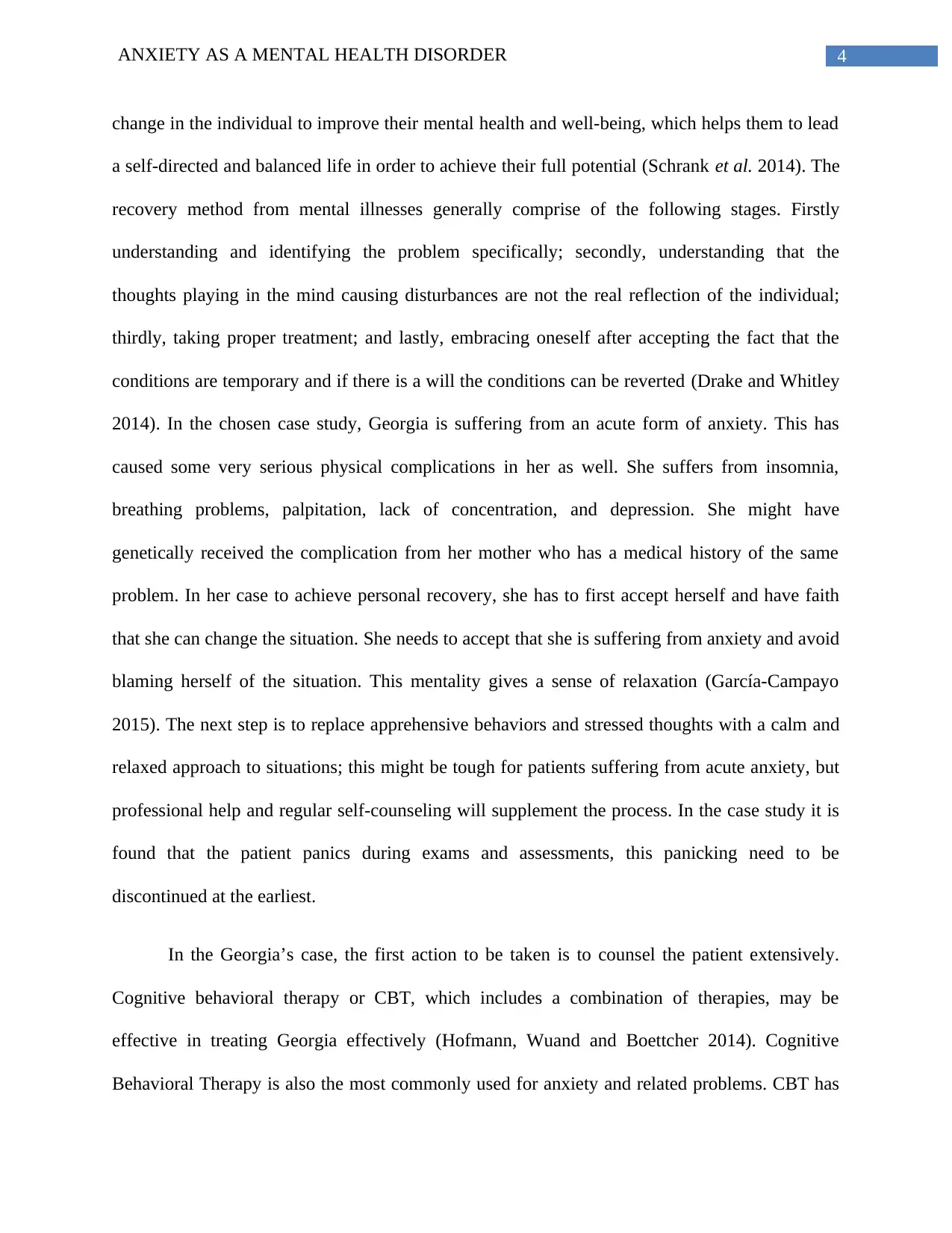
4ANXIETY AS A MENTAL HEALTH DISORDER
change in the individual to improve their mental health and well-being, which helps them to lead
a self-directed and balanced life in order to achieve their full potential (Schrank et al. 2014). The
recovery method from mental illnesses generally comprise of the following stages. Firstly
understanding and identifying the problem specifically; secondly, understanding that the
thoughts playing in the mind causing disturbances are not the real reflection of the individual;
thirdly, taking proper treatment; and lastly, embracing oneself after accepting the fact that the
conditions are temporary and if there is a will the conditions can be reverted (Drake and Whitley
2014). In the chosen case study, Georgia is suffering from an acute form of anxiety. This has
caused some very serious physical complications in her as well. She suffers from insomnia,
breathing problems, palpitation, lack of concentration, and depression. She might have
genetically received the complication from her mother who has a medical history of the same
problem. In her case to achieve personal recovery, she has to first accept herself and have faith
that she can change the situation. She needs to accept that she is suffering from anxiety and avoid
blaming herself of the situation. This mentality gives a sense of relaxation (García-Campayo
2015). The next step is to replace apprehensive behaviors and stressed thoughts with a calm and
relaxed approach to situations; this might be tough for patients suffering from acute anxiety, but
professional help and regular self-counseling will supplement the process. In the case study it is
found that the patient panics during exams and assessments, this panicking need to be
discontinued at the earliest.
In the Georgia’s case, the first action to be taken is to counsel the patient extensively.
Cognitive behavioral therapy or CBT, which includes a combination of therapies, may be
effective in treating Georgia effectively (Hofmann, Wuand and Boettcher 2014). Cognitive
Behavioral Therapy is also the most commonly used for anxiety and related problems. CBT has
change in the individual to improve their mental health and well-being, which helps them to lead
a self-directed and balanced life in order to achieve their full potential (Schrank et al. 2014). The
recovery method from mental illnesses generally comprise of the following stages. Firstly
understanding and identifying the problem specifically; secondly, understanding that the
thoughts playing in the mind causing disturbances are not the real reflection of the individual;
thirdly, taking proper treatment; and lastly, embracing oneself after accepting the fact that the
conditions are temporary and if there is a will the conditions can be reverted (Drake and Whitley
2014). In the chosen case study, Georgia is suffering from an acute form of anxiety. This has
caused some very serious physical complications in her as well. She suffers from insomnia,
breathing problems, palpitation, lack of concentration, and depression. She might have
genetically received the complication from her mother who has a medical history of the same
problem. In her case to achieve personal recovery, she has to first accept herself and have faith
that she can change the situation. She needs to accept that she is suffering from anxiety and avoid
blaming herself of the situation. This mentality gives a sense of relaxation (García-Campayo
2015). The next step is to replace apprehensive behaviors and stressed thoughts with a calm and
relaxed approach to situations; this might be tough for patients suffering from acute anxiety, but
professional help and regular self-counseling will supplement the process. In the case study it is
found that the patient panics during exams and assessments, this panicking need to be
discontinued at the earliest.
In the Georgia’s case, the first action to be taken is to counsel the patient extensively.
Cognitive behavioral therapy or CBT, which includes a combination of therapies, may be
effective in treating Georgia effectively (Hofmann, Wuand and Boettcher 2014). Cognitive
Behavioral Therapy is also the most commonly used for anxiety and related problems. CBT has
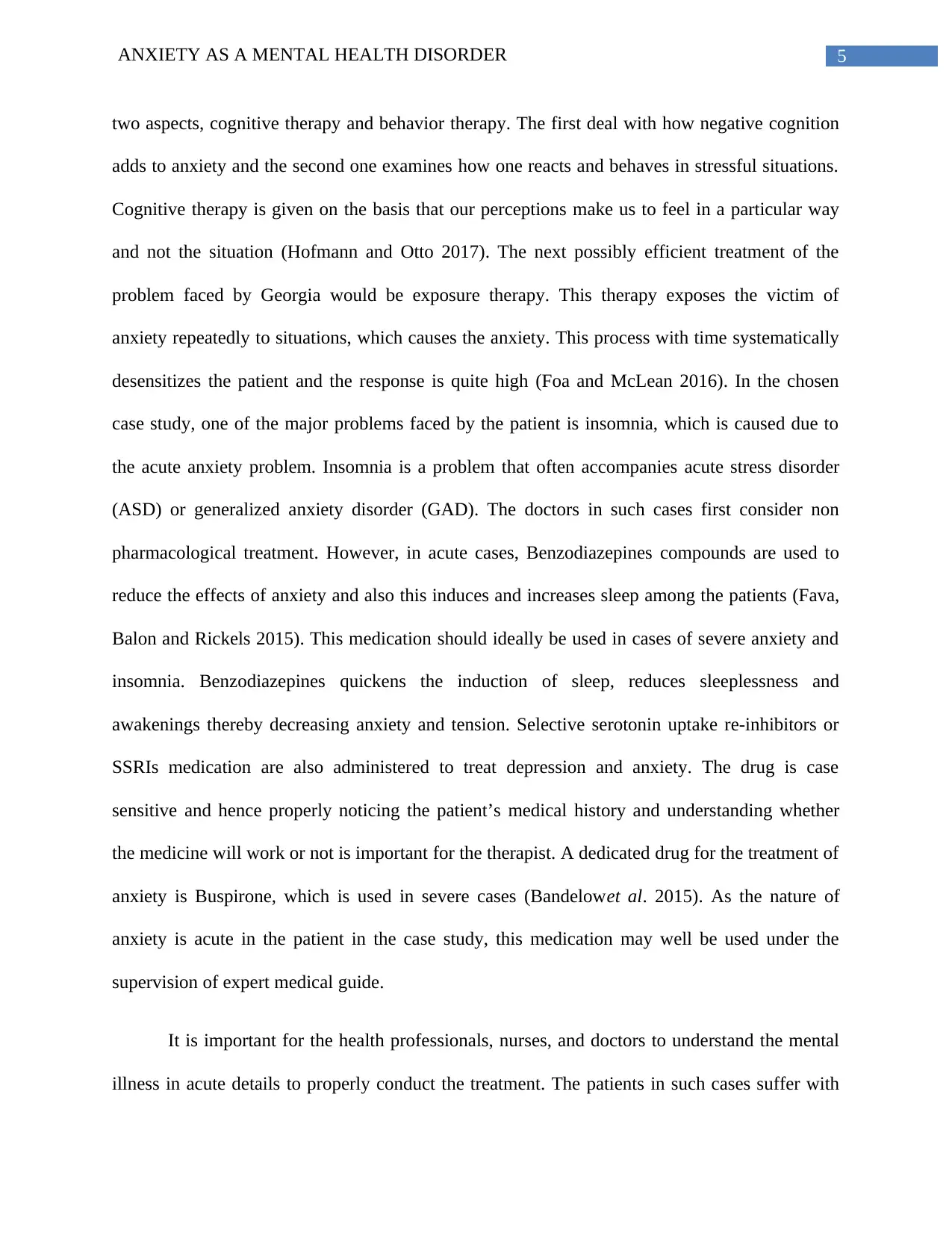
5ANXIETY AS A MENTAL HEALTH DISORDER
two aspects, cognitive therapy and behavior therapy. The first deal with how negative cognition
adds to anxiety and the second one examines how one reacts and behaves in stressful situations.
Cognitive therapy is given on the basis that our perceptions make us to feel in a particular way
and not the situation (Hofmann and Otto 2017). The next possibly efficient treatment of the
problem faced by Georgia would be exposure therapy. This therapy exposes the victim of
anxiety repeatedly to situations, which causes the anxiety. This process with time systematically
desensitizes the patient and the response is quite high (Foa and McLean 2016). In the chosen
case study, one of the major problems faced by the patient is insomnia, which is caused due to
the acute anxiety problem. Insomnia is a problem that often accompanies acute stress disorder
(ASD) or generalized anxiety disorder (GAD). The doctors in such cases first consider non
pharmacological treatment. However, in acute cases, Benzodiazepines compounds are used to
reduce the effects of anxiety and also this induces and increases sleep among the patients (Fava,
Balon and Rickels 2015). This medication should ideally be used in cases of severe anxiety and
insomnia. Benzodiazepines quickens the induction of sleep, reduces sleeplessness and
awakenings thereby decreasing anxiety and tension. Selective serotonin uptake re-inhibitors or
SSRIs medication are also administered to treat depression and anxiety. The drug is case
sensitive and hence properly noticing the patient’s medical history and understanding whether
the medicine will work or not is important for the therapist. A dedicated drug for the treatment of
anxiety is Buspirone, which is used in severe cases (Bandelowet al. 2015). As the nature of
anxiety is acute in the patient in the case study, this medication may well be used under the
supervision of expert medical guide.
It is important for the health professionals, nurses, and doctors to understand the mental
illness in acute details to properly conduct the treatment. The patients in such cases suffer with
two aspects, cognitive therapy and behavior therapy. The first deal with how negative cognition
adds to anxiety and the second one examines how one reacts and behaves in stressful situations.
Cognitive therapy is given on the basis that our perceptions make us to feel in a particular way
and not the situation (Hofmann and Otto 2017). The next possibly efficient treatment of the
problem faced by Georgia would be exposure therapy. This therapy exposes the victim of
anxiety repeatedly to situations, which causes the anxiety. This process with time systematically
desensitizes the patient and the response is quite high (Foa and McLean 2016). In the chosen
case study, one of the major problems faced by the patient is insomnia, which is caused due to
the acute anxiety problem. Insomnia is a problem that often accompanies acute stress disorder
(ASD) or generalized anxiety disorder (GAD). The doctors in such cases first consider non
pharmacological treatment. However, in acute cases, Benzodiazepines compounds are used to
reduce the effects of anxiety and also this induces and increases sleep among the patients (Fava,
Balon and Rickels 2015). This medication should ideally be used in cases of severe anxiety and
insomnia. Benzodiazepines quickens the induction of sleep, reduces sleeplessness and
awakenings thereby decreasing anxiety and tension. Selective serotonin uptake re-inhibitors or
SSRIs medication are also administered to treat depression and anxiety. The drug is case
sensitive and hence properly noticing the patient’s medical history and understanding whether
the medicine will work or not is important for the therapist. A dedicated drug for the treatment of
anxiety is Buspirone, which is used in severe cases (Bandelowet al. 2015). As the nature of
anxiety is acute in the patient in the case study, this medication may well be used under the
supervision of expert medical guide.
It is important for the health professionals, nurses, and doctors to understand the mental
illness in acute details to properly conduct the treatment. The patients in such cases suffer with
⊘ This is a preview!⊘
Do you want full access?
Subscribe today to unlock all pages.

Trusted by 1+ million students worldwide
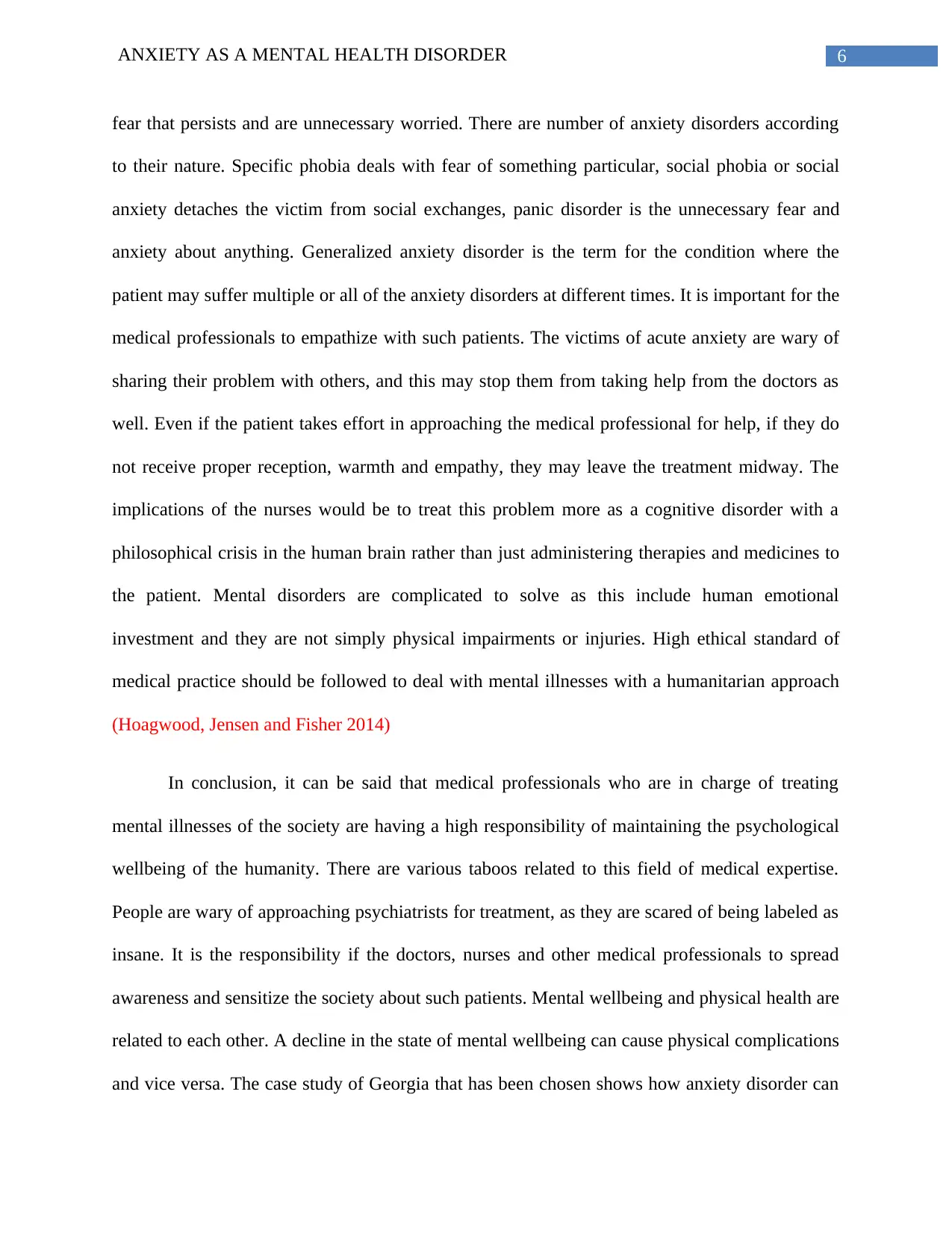
6ANXIETY AS A MENTAL HEALTH DISORDER
fear that persists and are unnecessary worried. There are number of anxiety disorders according
to their nature. Specific phobia deals with fear of something particular, social phobia or social
anxiety detaches the victim from social exchanges, panic disorder is the unnecessary fear and
anxiety about anything. Generalized anxiety disorder is the term for the condition where the
patient may suffer multiple or all of the anxiety disorders at different times. It is important for the
medical professionals to empathize with such patients. The victims of acute anxiety are wary of
sharing their problem with others, and this may stop them from taking help from the doctors as
well. Even if the patient takes effort in approaching the medical professional for help, if they do
not receive proper reception, warmth and empathy, they may leave the treatment midway. The
implications of the nurses would be to treat this problem more as a cognitive disorder with a
philosophical crisis in the human brain rather than just administering therapies and medicines to
the patient. Mental disorders are complicated to solve as this include human emotional
investment and they are not simply physical impairments or injuries. High ethical standard of
medical practice should be followed to deal with mental illnesses with a humanitarian approach
(Hoagwood, Jensen and Fisher 2014)
In conclusion, it can be said that medical professionals who are in charge of treating
mental illnesses of the society are having a high responsibility of maintaining the psychological
wellbeing of the humanity. There are various taboos related to this field of medical expertise.
People are wary of approaching psychiatrists for treatment, as they are scared of being labeled as
insane. It is the responsibility if the doctors, nurses and other medical professionals to spread
awareness and sensitize the society about such patients. Mental wellbeing and physical health are
related to each other. A decline in the state of mental wellbeing can cause physical complications
and vice versa. The case study of Georgia that has been chosen shows how anxiety disorder can
fear that persists and are unnecessary worried. There are number of anxiety disorders according
to their nature. Specific phobia deals with fear of something particular, social phobia or social
anxiety detaches the victim from social exchanges, panic disorder is the unnecessary fear and
anxiety about anything. Generalized anxiety disorder is the term for the condition where the
patient may suffer multiple or all of the anxiety disorders at different times. It is important for the
medical professionals to empathize with such patients. The victims of acute anxiety are wary of
sharing their problem with others, and this may stop them from taking help from the doctors as
well. Even if the patient takes effort in approaching the medical professional for help, if they do
not receive proper reception, warmth and empathy, they may leave the treatment midway. The
implications of the nurses would be to treat this problem more as a cognitive disorder with a
philosophical crisis in the human brain rather than just administering therapies and medicines to
the patient. Mental disorders are complicated to solve as this include human emotional
investment and they are not simply physical impairments or injuries. High ethical standard of
medical practice should be followed to deal with mental illnesses with a humanitarian approach
(Hoagwood, Jensen and Fisher 2014)
In conclusion, it can be said that medical professionals who are in charge of treating
mental illnesses of the society are having a high responsibility of maintaining the psychological
wellbeing of the humanity. There are various taboos related to this field of medical expertise.
People are wary of approaching psychiatrists for treatment, as they are scared of being labeled as
insane. It is the responsibility if the doctors, nurses and other medical professionals to spread
awareness and sensitize the society about such patients. Mental wellbeing and physical health are
related to each other. A decline in the state of mental wellbeing can cause physical complications
and vice versa. The case study of Georgia that has been chosen shows how anxiety disorder can
Paraphrase This Document
Need a fresh take? Get an instant paraphrase of this document with our AI Paraphraser
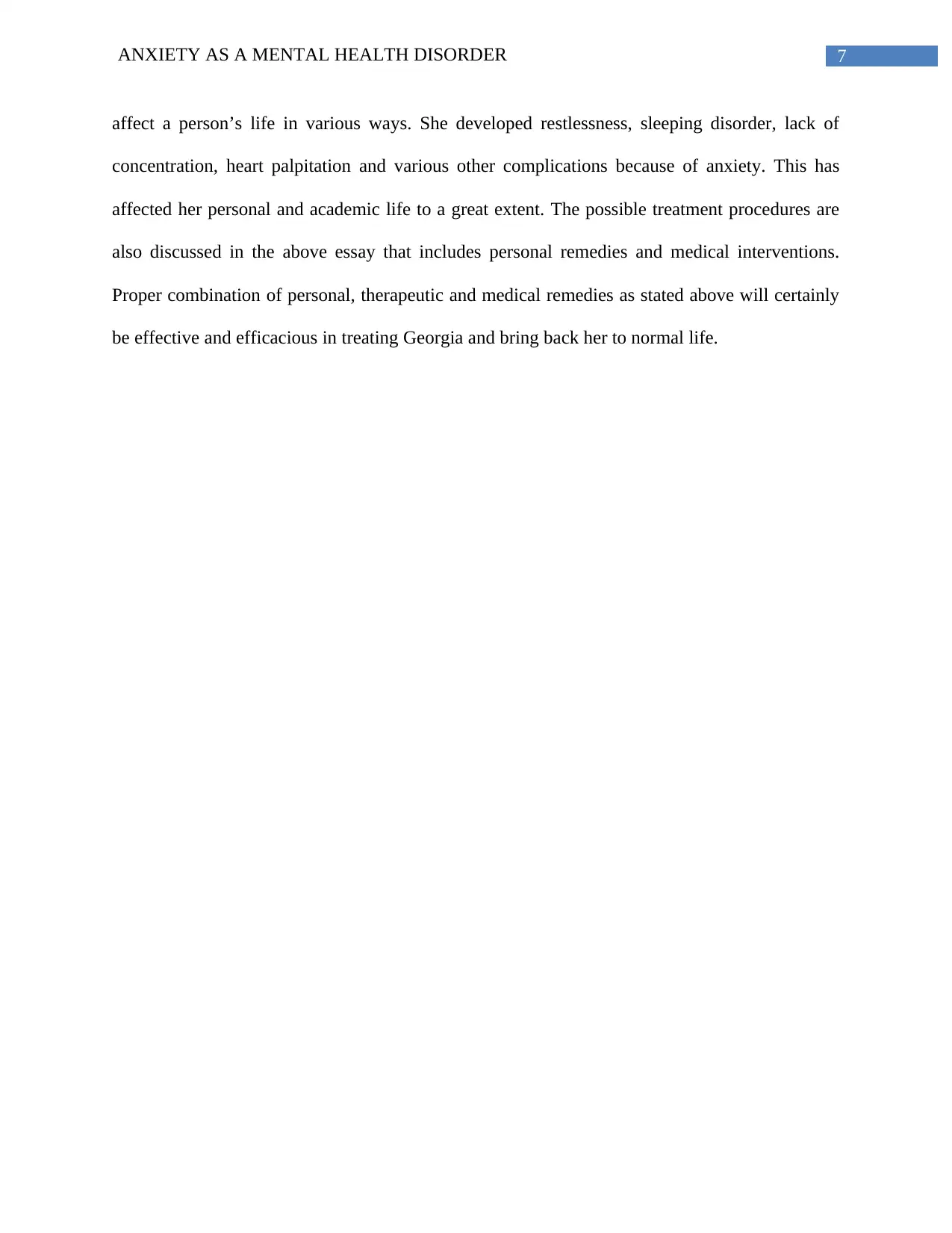
7ANXIETY AS A MENTAL HEALTH DISORDER
affect a person’s life in various ways. She developed restlessness, sleeping disorder, lack of
concentration, heart palpitation and various other complications because of anxiety. This has
affected her personal and academic life to a great extent. The possible treatment procedures are
also discussed in the above essay that includes personal remedies and medical interventions.
Proper combination of personal, therapeutic and medical remedies as stated above will certainly
be effective and efficacious in treating Georgia and bring back her to normal life.
affect a person’s life in various ways. She developed restlessness, sleeping disorder, lack of
concentration, heart palpitation and various other complications because of anxiety. This has
affected her personal and academic life to a great extent. The possible treatment procedures are
also discussed in the above essay that includes personal remedies and medical interventions.
Proper combination of personal, therapeutic and medical remedies as stated above will certainly
be effective and efficacious in treating Georgia and bring back her to normal life.
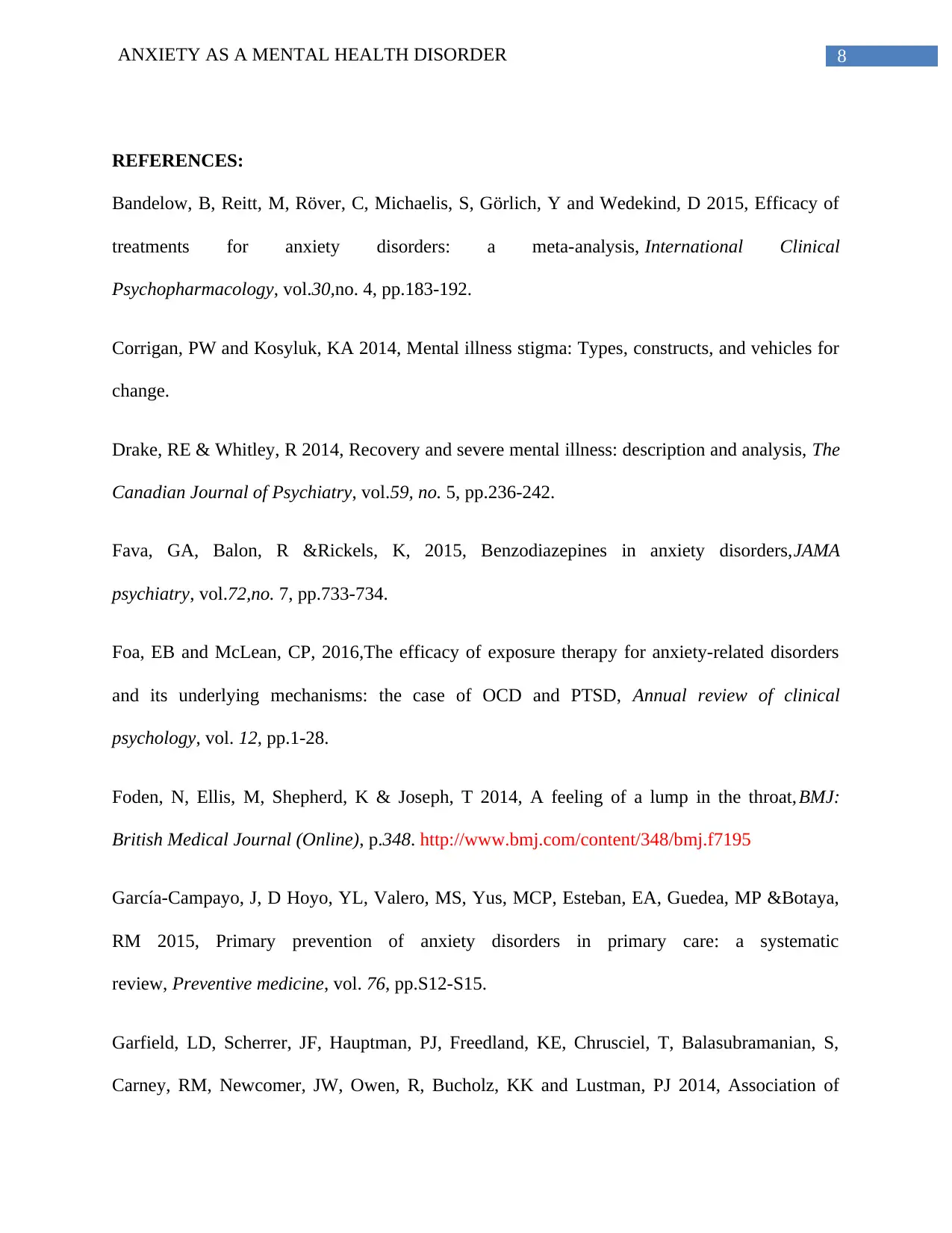
8ANXIETY AS A MENTAL HEALTH DISORDER
REFERENCES:
Bandelow, B, Reitt, M, Röver, C, Michaelis, S, Görlich, Y and Wedekind, D 2015, Efficacy of
treatments for anxiety disorders: a meta-analysis, International Clinical
Psychopharmacology, vol.30,no. 4, pp.183-192.
Corrigan, PW and Kosyluk, KA 2014, Mental illness stigma: Types, constructs, and vehicles for
change.
Drake, RE & Whitley, R 2014, Recovery and severe mental illness: description and analysis, The
Canadian Journal of Psychiatry, vol.59, no. 5, pp.236-242.
Fava, GA, Balon, R &Rickels, K, 2015, Benzodiazepines in anxiety disorders,JAMA
psychiatry, vol.72,no. 7, pp.733-734.
Foa, EB and McLean, CP, 2016,The efficacy of exposure therapy for anxiety-related disorders
and its underlying mechanisms: the case of OCD and PTSD, Annual review of clinical
psychology, vol. 12, pp.1-28.
Foden, N, Ellis, M, Shepherd, K & Joseph, T 2014, A feeling of a lump in the throat, BMJ:
British Medical Journal (Online), p.348. http://www.bmj.com/content/348/bmj.f7195
García-Campayo, J, D Hoyo, YL, Valero, MS, Yus, MCP, Esteban, EA, Guedea, MP &Botaya,
RM 2015, Primary prevention of anxiety disorders in primary care: a systematic
review, Preventive medicine, vol. 76, pp.S12-S15.
Garfield, LD, Scherrer, JF, Hauptman, PJ, Freedland, KE, Chrusciel, T, Balasubramanian, S,
Carney, RM, Newcomer, JW, Owen, R, Bucholz, KK and Lustman, PJ 2014, Association of
REFERENCES:
Bandelow, B, Reitt, M, Röver, C, Michaelis, S, Görlich, Y and Wedekind, D 2015, Efficacy of
treatments for anxiety disorders: a meta-analysis, International Clinical
Psychopharmacology, vol.30,no. 4, pp.183-192.
Corrigan, PW and Kosyluk, KA 2014, Mental illness stigma: Types, constructs, and vehicles for
change.
Drake, RE & Whitley, R 2014, Recovery and severe mental illness: description and analysis, The
Canadian Journal of Psychiatry, vol.59, no. 5, pp.236-242.
Fava, GA, Balon, R &Rickels, K, 2015, Benzodiazepines in anxiety disorders,JAMA
psychiatry, vol.72,no. 7, pp.733-734.
Foa, EB and McLean, CP, 2016,The efficacy of exposure therapy for anxiety-related disorders
and its underlying mechanisms: the case of OCD and PTSD, Annual review of clinical
psychology, vol. 12, pp.1-28.
Foden, N, Ellis, M, Shepherd, K & Joseph, T 2014, A feeling of a lump in the throat, BMJ:
British Medical Journal (Online), p.348. http://www.bmj.com/content/348/bmj.f7195
García-Campayo, J, D Hoyo, YL, Valero, MS, Yus, MCP, Esteban, EA, Guedea, MP &Botaya,
RM 2015, Primary prevention of anxiety disorders in primary care: a systematic
review, Preventive medicine, vol. 76, pp.S12-S15.
Garfield, LD, Scherrer, JF, Hauptman, PJ, Freedland, KE, Chrusciel, T, Balasubramanian, S,
Carney, RM, Newcomer, JW, Owen, R, Bucholz, KK and Lustman, PJ 2014, Association of
⊘ This is a preview!⊘
Do you want full access?
Subscribe today to unlock all pages.

Trusted by 1+ million students worldwide
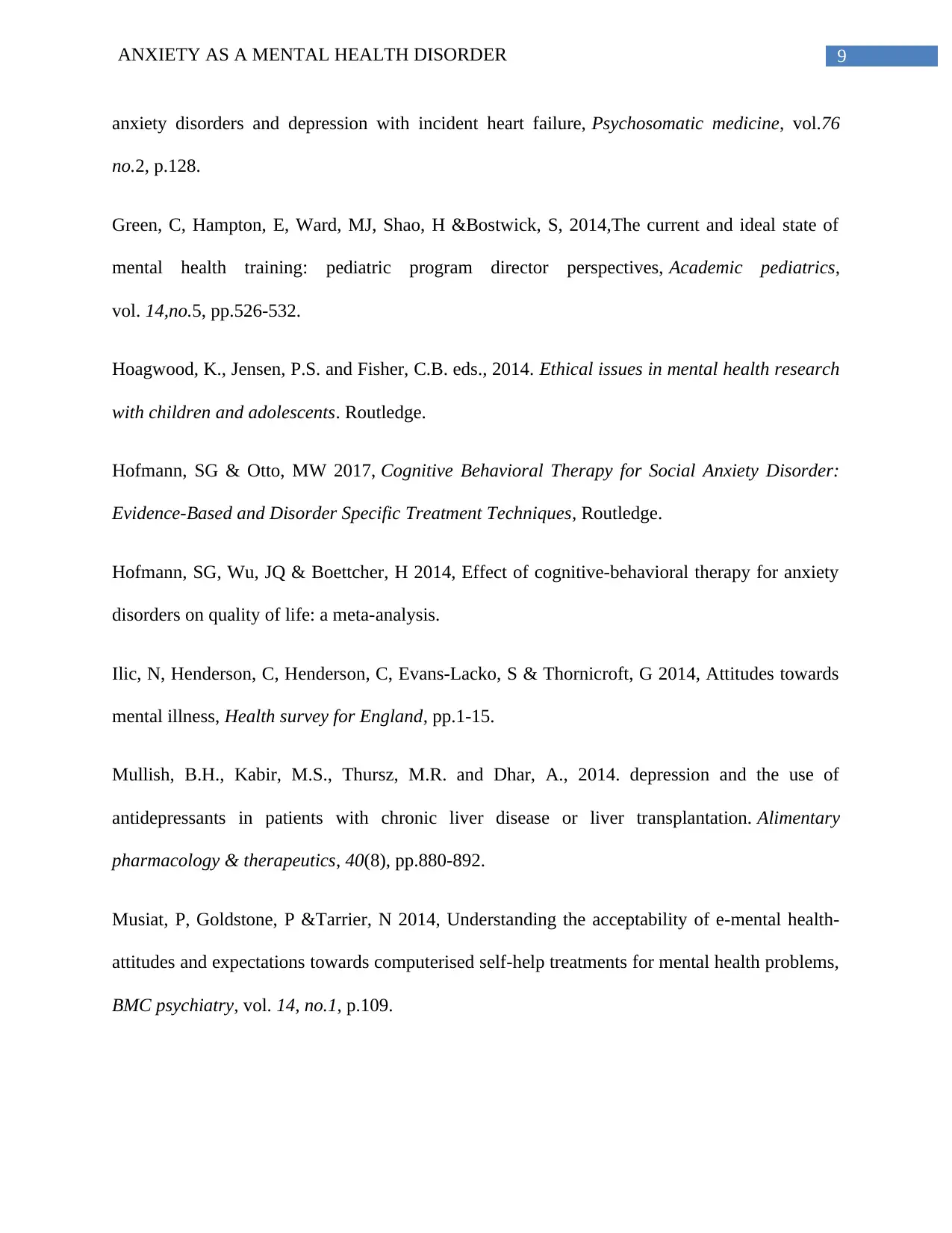
9ANXIETY AS A MENTAL HEALTH DISORDER
anxiety disorders and depression with incident heart failure, Psychosomatic medicine, vol.76
no.2, p.128.
Green, C, Hampton, E, Ward, MJ, Shao, H &Bostwick, S, 2014,The current and ideal state of
mental health training: pediatric program director perspectives, Academic pediatrics,
vol. 14,no.5, pp.526-532.
Hoagwood, K., Jensen, P.S. and Fisher, C.B. eds., 2014. Ethical issues in mental health research
with children and adolescents. Routledge.
Hofmann, SG & Otto, MW 2017, Cognitive Behavioral Therapy for Social Anxiety Disorder:
Evidence-Based and Disorder Specific Treatment Techniques, Routledge.
Hofmann, SG, Wu, JQ & Boettcher, H 2014, Effect of cognitive-behavioral therapy for anxiety
disorders on quality of life: a meta-analysis.
Ilic, N, Henderson, C, Henderson, C, Evans-Lacko, S & Thornicroft, G 2014, Attitudes towards
mental illness, Health survey for England, pp.1-15.
Mullish, B.H., Kabir, M.S., Thursz, M.R. and Dhar, A., 2014. depression and the use of
antidepressants in patients with chronic liver disease or liver transplantation. Alimentary
pharmacology & therapeutics, 40(8), pp.880-892.
Musiat, P, Goldstone, P &Tarrier, N 2014, Understanding the acceptability of e-mental health-
attitudes and expectations towards computerised self-help treatments for mental health problems,
BMC psychiatry, vol. 14, no.1, p.109.
anxiety disorders and depression with incident heart failure, Psychosomatic medicine, vol.76
no.2, p.128.
Green, C, Hampton, E, Ward, MJ, Shao, H &Bostwick, S, 2014,The current and ideal state of
mental health training: pediatric program director perspectives, Academic pediatrics,
vol. 14,no.5, pp.526-532.
Hoagwood, K., Jensen, P.S. and Fisher, C.B. eds., 2014. Ethical issues in mental health research
with children and adolescents. Routledge.
Hofmann, SG & Otto, MW 2017, Cognitive Behavioral Therapy for Social Anxiety Disorder:
Evidence-Based and Disorder Specific Treatment Techniques, Routledge.
Hofmann, SG, Wu, JQ & Boettcher, H 2014, Effect of cognitive-behavioral therapy for anxiety
disorders on quality of life: a meta-analysis.
Ilic, N, Henderson, C, Henderson, C, Evans-Lacko, S & Thornicroft, G 2014, Attitudes towards
mental illness, Health survey for England, pp.1-15.
Mullish, B.H., Kabir, M.S., Thursz, M.R. and Dhar, A., 2014. depression and the use of
antidepressants in patients with chronic liver disease or liver transplantation. Alimentary
pharmacology & therapeutics, 40(8), pp.880-892.
Musiat, P, Goldstone, P &Tarrier, N 2014, Understanding the acceptability of e-mental health-
attitudes and expectations towards computerised self-help treatments for mental health problems,
BMC psychiatry, vol. 14, no.1, p.109.
Paraphrase This Document
Need a fresh take? Get an instant paraphrase of this document with our AI Paraphraser
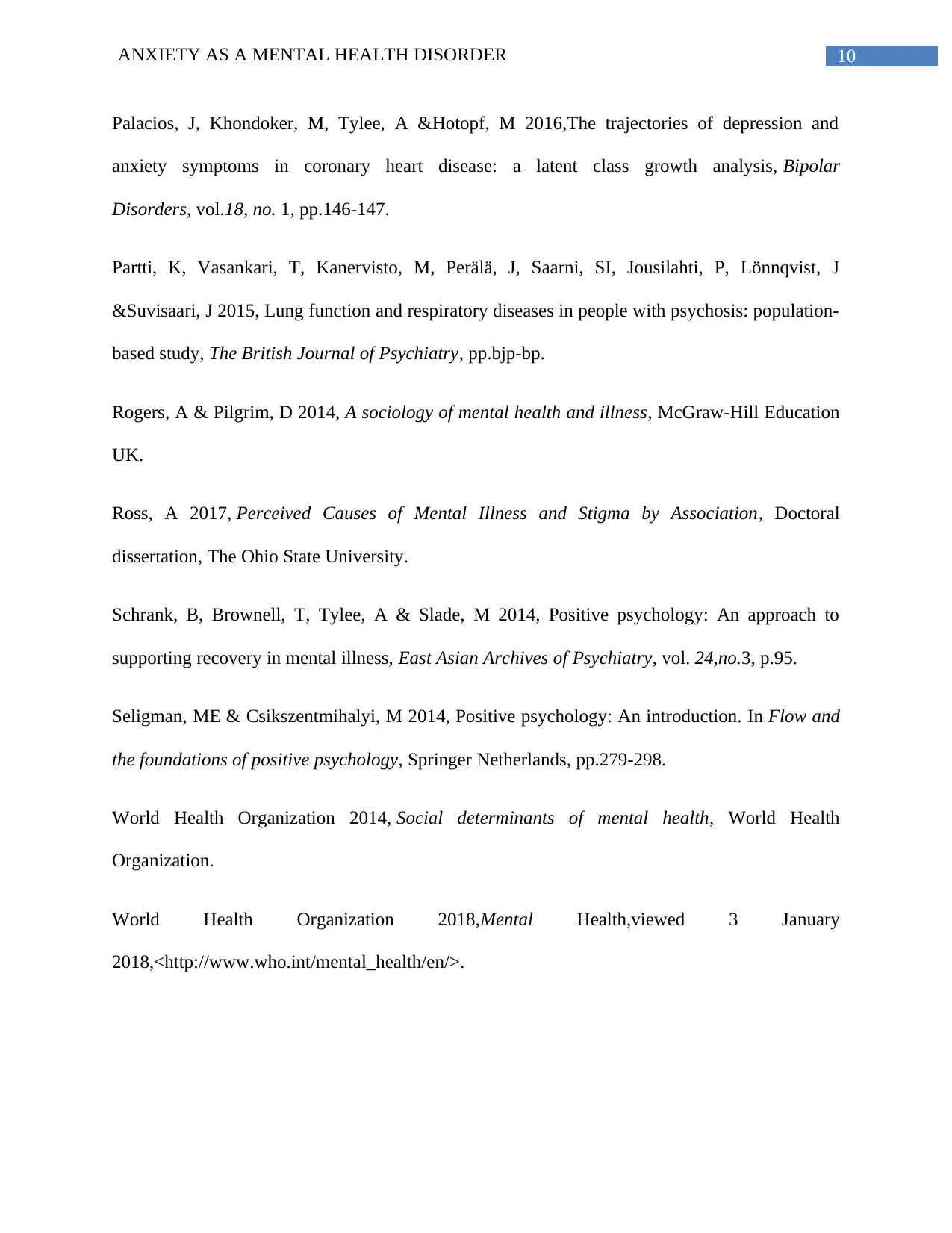
10ANXIETY AS A MENTAL HEALTH DISORDER
Palacios, J, Khondoker, M, Tylee, A &Hotopf, M 2016,The trajectories of depression and
anxiety symptoms in coronary heart disease: a latent class growth analysis, Bipolar
Disorders, vol.18, no. 1, pp.146-147.
Partti, K, Vasankari, T, Kanervisto, M, Perälä, J, Saarni, SI, Jousilahti, P, Lönnqvist, J
&Suvisaari, J 2015, Lung function and respiratory diseases in people with psychosis: population-
based study, The British Journal of Psychiatry, pp.bjp-bp.
Rogers, A & Pilgrim, D 2014, A sociology of mental health and illness, McGraw-Hill Education
UK.
Ross, A 2017, Perceived Causes of Mental Illness and Stigma by Association, Doctoral
dissertation, The Ohio State University.
Schrank, B, Brownell, T, Tylee, A & Slade, M 2014, Positive psychology: An approach to
supporting recovery in mental illness, East Asian Archives of Psychiatry, vol. 24,no.3, p.95.
Seligman, ME & Csikszentmihalyi, M 2014, Positive psychology: An introduction. In Flow and
the foundations of positive psychology, Springer Netherlands, pp.279-298.
World Health Organization 2014, Social determinants of mental health, World Health
Organization.
World Health Organization 2018,Mental Health,viewed 3 January
2018,<http://www.who.int/mental_health/en/>.
Palacios, J, Khondoker, M, Tylee, A &Hotopf, M 2016,The trajectories of depression and
anxiety symptoms in coronary heart disease: a latent class growth analysis, Bipolar
Disorders, vol.18, no. 1, pp.146-147.
Partti, K, Vasankari, T, Kanervisto, M, Perälä, J, Saarni, SI, Jousilahti, P, Lönnqvist, J
&Suvisaari, J 2015, Lung function and respiratory diseases in people with psychosis: population-
based study, The British Journal of Psychiatry, pp.bjp-bp.
Rogers, A & Pilgrim, D 2014, A sociology of mental health and illness, McGraw-Hill Education
UK.
Ross, A 2017, Perceived Causes of Mental Illness and Stigma by Association, Doctoral
dissertation, The Ohio State University.
Schrank, B, Brownell, T, Tylee, A & Slade, M 2014, Positive psychology: An approach to
supporting recovery in mental illness, East Asian Archives of Psychiatry, vol. 24,no.3, p.95.
Seligman, ME & Csikszentmihalyi, M 2014, Positive psychology: An introduction. In Flow and
the foundations of positive psychology, Springer Netherlands, pp.279-298.
World Health Organization 2014, Social determinants of mental health, World Health
Organization.
World Health Organization 2018,Mental Health,viewed 3 January
2018,<http://www.who.int/mental_health/en/>.
1 out of 11
Related Documents
Your All-in-One AI-Powered Toolkit for Academic Success.
+13062052269
info@desklib.com
Available 24*7 on WhatsApp / Email
![[object Object]](/_next/static/media/star-bottom.7253800d.svg)
Unlock your academic potential
Copyright © 2020–2025 A2Z Services. All Rights Reserved. Developed and managed by ZUCOL.




![Coursework: Mental Health and Wellbeing of Older People - [University]](/_next/image/?url=https%3A%2F%2Fdesklib.com%2Fmedia%2Fimages%2Fyr%2F3c92269340094292bd18c0d2d99c9706.jpg&w=256&q=75)
